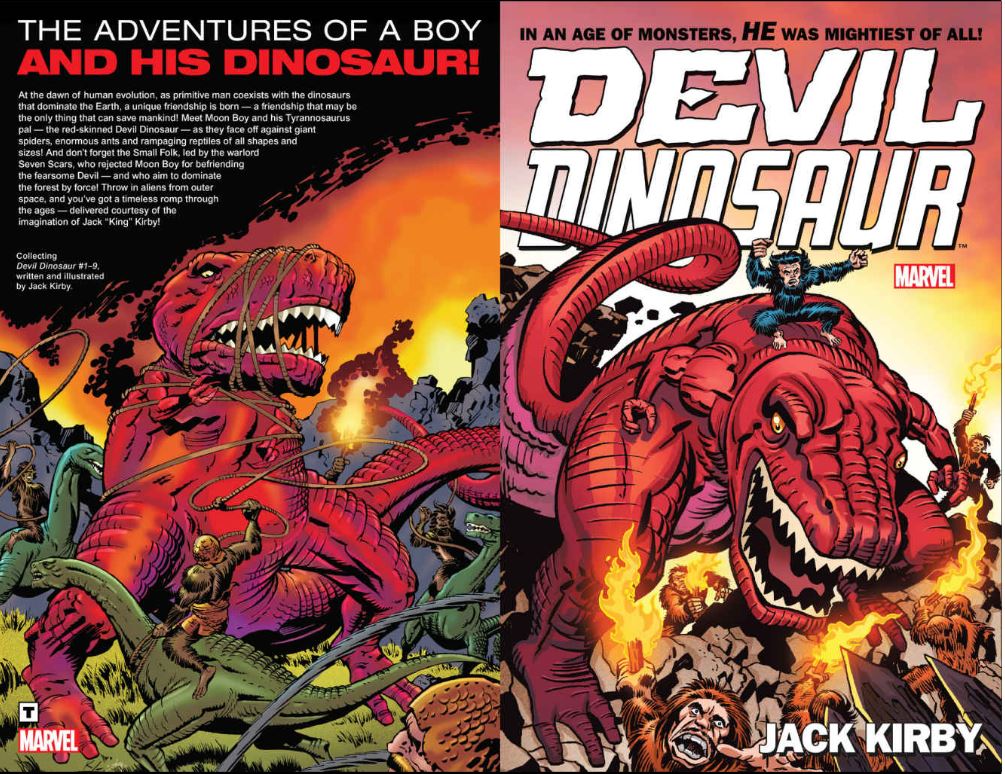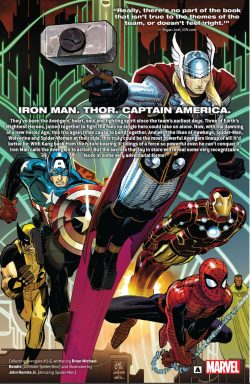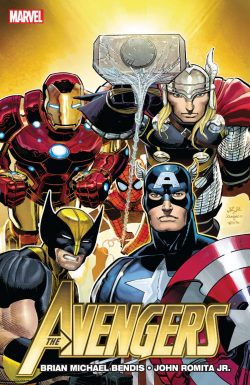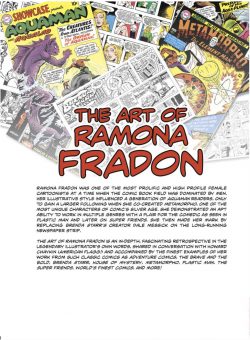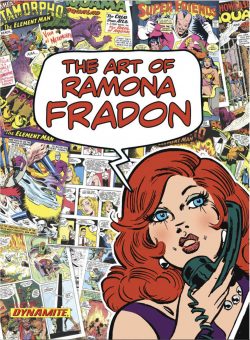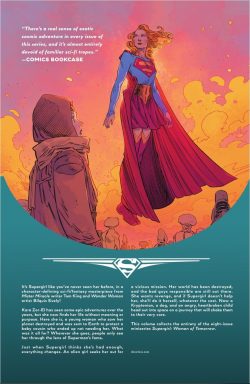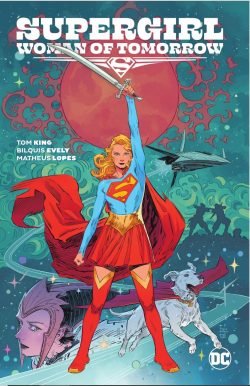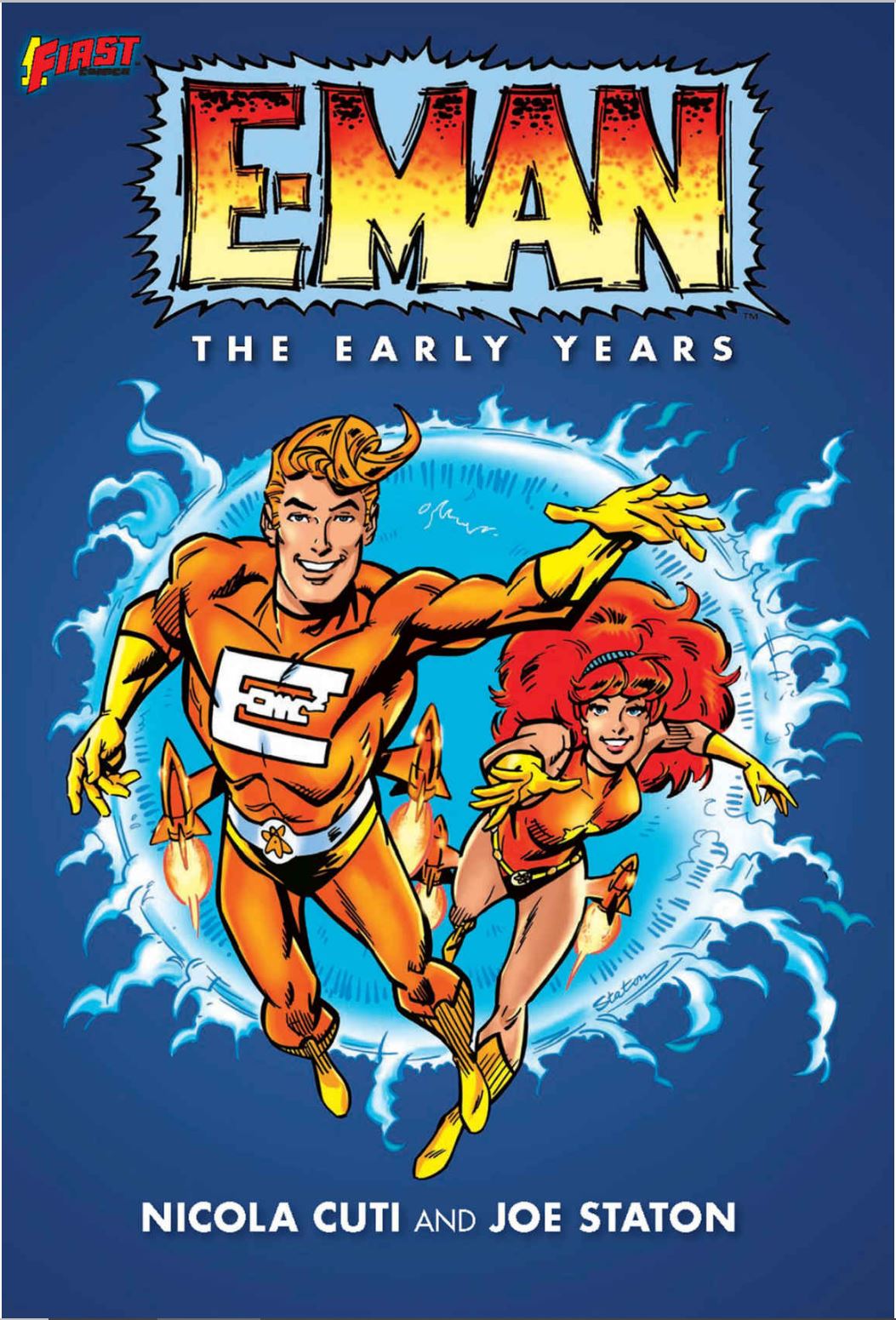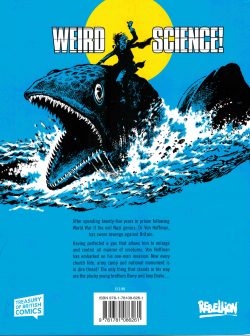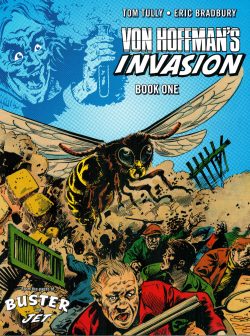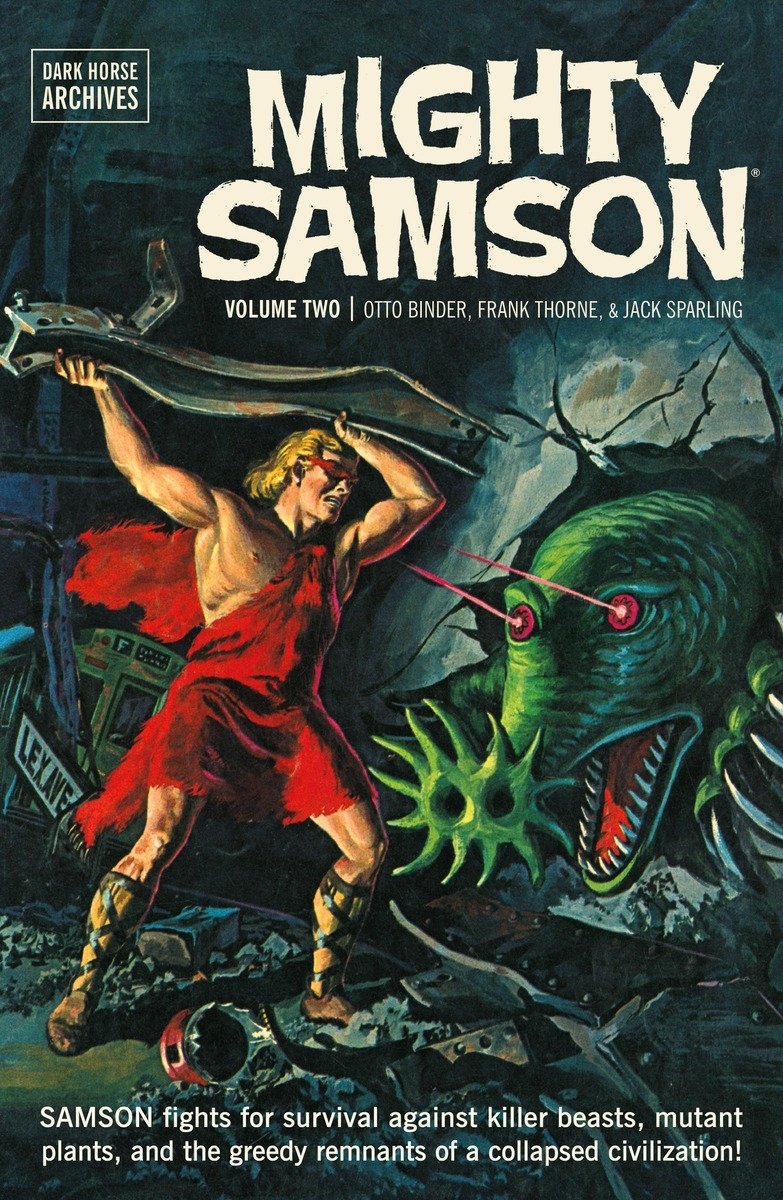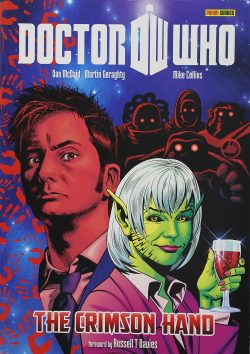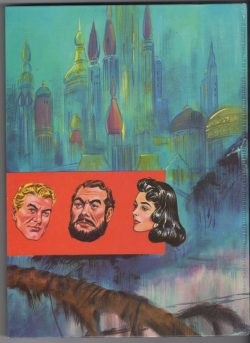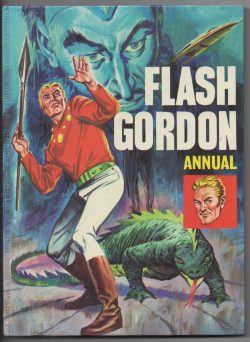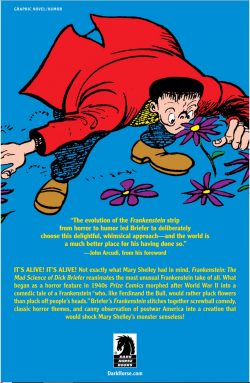
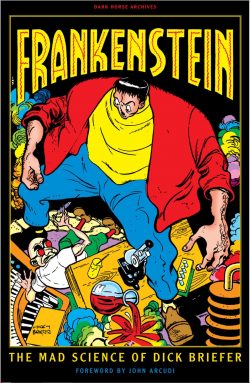
By Dick Briefer with Bruce Elliott & various (Dark Horse Comics)
ISBN: 978-1-61655-688-4 eISBN: 978-1-63008-186-7
The Golden Age of American comic books is usually associated with the blockbusting birth and proliferation of the Superhero, but even at the headiest heights of costumed crusader craziness other fantastic fantasy fashions held their own. Some of the very best – like Jack Cole’s Plastic Man and the unlikely weird warrior under discussion here – managed to merge genres and surmount their origins through astounding graphic craft, a healthy helping of comedic legerdemain and a deft dose of satire…
Richard Briefer was born in Washington Heights, Manhattan on January 9th 1915. He was a pre-Med student who also studied at the Art Student League in New York City and got into the fledgling funnybook business in 1936, working for the Will Eisner/Jerry Iger shop after selling early work to Wow, What a Magazine! and others.
He adapted literary classics like the Hunchback of Notre Dame and – as Dick Hamilton – created early super-team Target and the Targeteers for Novelty Press. Briefer wrote and drew Rex Dexter of Mars, Dynamo, Biff Bannon, Storm Curtis, Crash Parker and more for a range of publishers. For Timely he co-created The Human Top and, as Dick Flood, produced anti-Nazi strip Pinky Rankin for The Daily Worker – the newspaper of the American Communist Party.
Another criminally near-forgotten master craftsman, Briefer is best remembered amongst we fading comics cognoscenti for Frankenstein; a suspense strip that debuted in Prize Comics #7 (cover-dated December 1940) before gradually evolving into a satirical comedy-horror masterpiece offering thrills and chills whilst ferociously sending up post-war America.
A truly unique vision, Briefer’s Frankenstein ran intermittently until 1954 when the toxic paranoiac atmosphere of the anti-communist, anti-comics witch hunt killed it. The author moved into advertising and latterly portraiture and, despite numerous attempts to revive the strip, never published any more of his absurd and acerbic antic…
Dick Briefer died in December 1980.
Here, however, as part of the wonderful and much missed Dark Horse Archives series (please bring ‘em back guys!), you can enjoy the superbly surreal strip in all its manic glory from the horrible heydays…
Re-presented for your delectation are the contents of Frankenstein #1-7 (January 1945-May 1947) with Briefer at the peak of his powers, writing and drawing deliciously demented delights that made him a legend amongst comics creators if not the general public.
After gleaning a few salient facts from appreciative devotee John Arcudi in his Foreword, and relishing some ultra-rare original art from Briefer and Alex Toth, the merry madness begins with #1 as we reveal ‘Frankenstein’s Creation’…
After a bored mad scientist reads an old book, he decides to create his own version of the infamous creature. Sadly, despite scrupulously following the recipe, the malevolent modern Prometheus’ secret formula only manifests a loving, protective nature in his super-strong homunculus, and the hulking “Frankenstein monster” soon becomes a boon to his community and embarrassment to his malignant maker.
Left to his own devices, our artificial Adam is then drawn to the quiet little everytown of Mippyville where the populace are fighting off a supernatural invasion of atrocious arcane predators. ‘Frankenstein and the Ghouls and Vampires’ sees the creature – originally mistaken for a “Bobbysox” pop singer by the town’s screaming teenagers – hilariously clean up the infernal infestation before setting up home in a ramshackle abandoned mansion.
Only one thing is missing to complete his dreams of domestic bliss until a brief dalliance with the local spider saleswoman results in her becoming ‘Frankenstein’s Wife’. The mild man-monster soon learns why a hasty marriage often leads to repentance at leisure…
Mippyville is a place that just attracts weirdness, and the first issue concludes with another mad doctor, as deranged surgeon Professor Hugo von Hoogenblotzen kidnaps Frankie and attempts to graft him to an elephant in ‘Frankenstein and the Manimals’…
The second issue begins with ‘Frankenstein!’ – a quick recap of past events – before our unlikely star tracks down a mad mass-murderer who wants others to suffer for his art in ‘Frankenstein and the Statue Maker’, after which the animal-loving oaf is accidentally mistaken for a mere beast and purchased by a moody millionairess.
She puts him on a leash to one-up her pals in the Exotic Pets Club but ‘Frankenstein’s Job’ soon teaches all and sundry the true value of animal companionship…
Eventually restored to his own home, ‘Frankenstein’s Ark’ finds the towering twit re-enacting the building of the fabled lifeboat to save his animal chums, but still ending up clashing with a hoarding hermit and his mutant allies…
Issue #3 (July/August 1946 and with scripting assistance from Bruce Elliott) introduced ‘Frankenstein’s Family’ as the big guy secures gainful employment as a junk man, whilst his new boss tinkers with salvaged machines from a devil doctor’s lab. This results in an army of molecularly-unstable juvenile duplicates of Frankie and a great deal of gross chaos…
A legion of escaped horrors attack Mippyville in ‘Frankenstein and the Monsters’, only to find the town’s ghastly defender too much to handle before ‘Frankenstein and the Mummies’ affords a quick jaunt to Egypt where the monster befriends a quartet of ancient, entombed pharaohs…
‘Frankenstein and the Time Machine’ apparently sends the credulous colossus into the furious future and perilous past, but all is not as it seems…
The regular cast expanded in the next issue (September/October 1946) as ‘Frankenstein and Awful Annie’ finds the mellow fellow aiding the local purveyor of potions and charms to the city’s supernatural community when her long-lost son wants to come home for a visit. After that debacle, he then makes another odd acquaintance in ‘Frankenstein Meets the (Terrible) Werewolf’ which debuts the gentlest magical man-eater on earth…
Another whirlwind romance goes awry after ‘Frankenstein Sees the Effect of the Youth Restorer’ and makes an amorously ill-advised move on a once-elderly neighbour, before his mystic mates throw the monster a birthday party in ‘Frankenstein and the Sorcerer’ and start a magic war that only subsides after the gentle giant accidentally lands a job as a photographic model…
Briefer was an inveterate tinkerer, always looking for innovative new ways to present mirthful material, and Frankenstein #5 (November/December 1946) trialled a new format of interlinked yarns beginning with ‘Act 1: How I Rehabilitated Maladjusted Ghosts’ as the creature becomes troubleshooter for the restless dead and unmasks a murderer.
In ‘Act 2: How I Had (and Lost) a Pet Dinosaur’, he accidentally hatches an antediluvian egg and manages to switch it with a parade-balloon doppelganger, whilst ‘Act 3: How I Became a Genii in a Magic Bottle’, sees the monster mysteriously abducted by a street-corner hustler before escaping to save the town from a malicious malady in concluding ‘Act 4: How I Conquered a Terrible Plague’. The experiment was dropped for a more traditional anthological format in the sixth (March/April 1947) issue…
Here the madcap merriment opens with ‘The Last Smile’ as Frankie is mistaken for a fugitive murderer and placed on death row, after which he hunts down ‘The Ghostnapper’ who abducts spirits and steals their big white sheets…
The rising cost of funerals informed the riotous case of ‘One Small Bier’ as the monster tries a new career as a mortician before heading into the country to investigate accursed, self-propagating automobiles going on an uncanny ‘Joyride’…
The final issue comes from May/June 1947 #7, opening with ‘Silas Grunch Gets His’ – co-written with Ed Goggin – as a conniving miser tortures kids by building a funfair children can’t get into… until the Big Guy steps in…
The monster plays cupid and brings two bizarre, lonely people together in ‘The Strange Love of Shirley Shmool’ with romance also informing Frankenstein’s laying of ‘The Curse of the Flying Dutchman’ Here the giant goof opens a Lonely Hearts Agency and matches the immortal wandering mariner with the girl of his nightmares! This leads to a clash with atom-age seductress ‘The Lorelei’ and a frankly hideous trading of jobs and gender roles before politics rears its ugly (multiple) heads as Frankenstein is convinced to run for President of the Magician’s Guild and endures the voodoo ‘Pins and Needles’ of a frustrated rival…
A truly unique treat from a singular and utterly eccentric creative force, Dick Briefer’s Frankenstein is remarkable work by a one-of-a-kind creator. If you groove on the grotesque, love to be scared, love to laugh and love comics, this is a book for you…
Frankenstein: The Mad Science of Dick Briefer. Dark Horse Books ® and logos are registered trademarks of Dark Horse Comics, Inc. All rights reserved.

